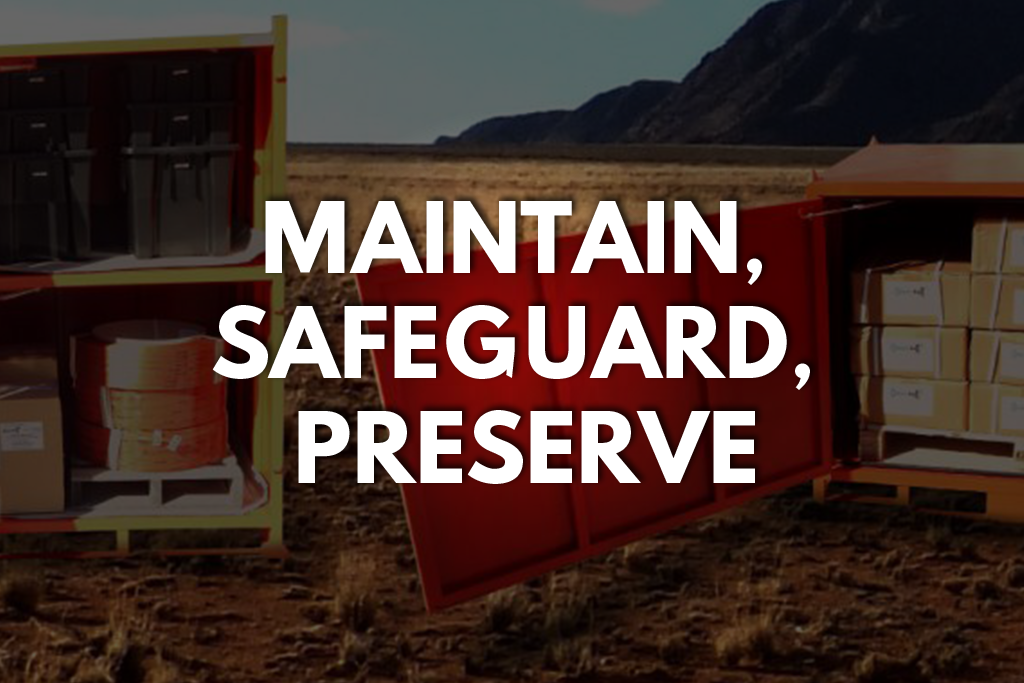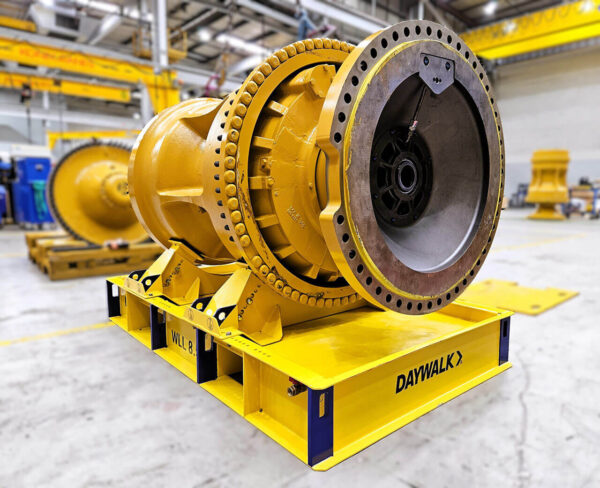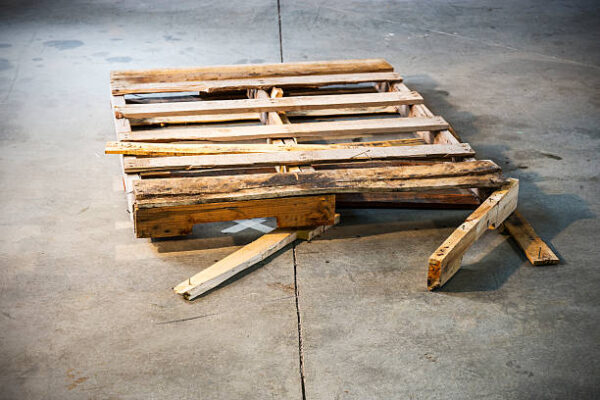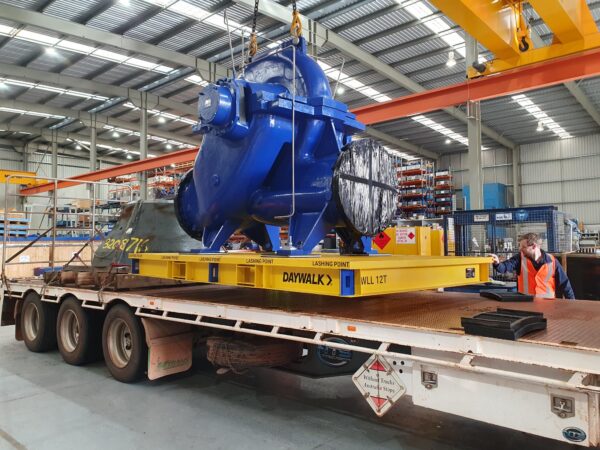When our warehouse was built some years back, and since then the inventory has grown to three times the original size.
Painpoint
As a result, we have had to start using a lay-down yard to store a lot of the big gear for our operation. The challenge that has just got more intense, as the years have gone by, is that there is extensive corrosion and deterioration due to the elements – harsh sun, intense UV, and also a lot of rain in the wet season. In addition, even the wind has an effect on these critical spares.
Solutions?
Are there any solutions on the market that can help us mitigate the effects of the elements?
One solution is to re-look at your warehouse space – as in under-cover storage and see if there is any further optimisation that can be gained by remodelling the racking, shelving and any other storage unit.
Increase vertical storage for smaller components
Some sites that store a lot of smaller components will utilise a carousel, which utilises vertical space; other sites will use compactus type shelving (as in mobile shelving) that also condenses the amount of floor space.
Racking
But we get it… the world that you are working in, your gear is heavy and big and often very large! – and the main storage solution is Pallet Racking and A-Frame Racking for your long length items.
Read: Pallets, Pallets, and more Pallets here
Stock, stock and more stock
The next step is to re-assess your stock items, line by line, and remove from stock the items that are redundant; but wait! We visited a site a few months back and there had just been a major move to reduce inventory and one of the person in charge had gone ahead and isolated a substantial number of old critical spares in view of removing the obsolete stock. Thankfully this was checked and stopped before the process was completed. While these items were indeed old and might have appeared to be obsolete, the fact was that the machinery was still in operation and if ever a part might have been needed there would have been very little to no chance at all to find the right spare again.
Who are the stakeholders?
So, be careful and make sure that all the necessary stakeholders are in the loop before going on a rampage of removing old ‘spares’! What we have found it is at times like these that you need to refer to certain members of the team that have been part of the company’s workforce for many years, as their knowledge of required parts as well as the challenges of previous breakdowns and associated nightmares, will still be indelibly etched in their memories. Don’t underestimate the value of these team members!
Analyse and Prioritise
Once you have defined and redefined what stock is critical and what can be made redundant and therefore be removed, you then need to prioritise all lines in order of importance, frequency of use, and also of course weather-durability.
There might be items that are currently sitting in your lay-down yard outside that are not resistant to the UV rays; one classic example of this is rubber and polymer linings, which can perish or crack. Wherever possible ensure that these items are sorted in the warehouse and store items that are less susceptible to weather damage outside.
Lean Practices
It is interesting to analyse the situation once you have removed and re-prioritised stock and stock holding levels. I have heard of a company, who engaged a Lean Consultant, to facilitate the introduction of improved processes in their warehouse operation. The Lean Principles that were implemented can be broken into the five S’s, as follows:
• Seiri (Sort)
• Seiton (Straighten, Set)
• Seiso (Shine, Sweep)
• Seiketsu (Standardize)
• Shitsuke (Sustain)
Need an additional warehouse?…or not!
At the beginning, management was telling the consultant that there would need to be an additional warehouse built to hold all the stock; as the company started to embrace lean principles and practices, a revolution took place and management starting finding spare space in their warehouse.
Measure twice, cut once!
Sometimes an additional warehouse is needed and justified; this is certainly an option. Take care her as well. Look at dimensions that will ensure the best use of the block. In addition to this, also work out the layout inside the warehouse – including the racking footprint and the aisles needed for the forklifts for other handling equipment. By making a warehouse a metre longer can make all the difference between the layout fitting and not fitting! Refer to the Australian Standard as well AS4084:2012, to find out best practice for Australian pallet racking, including the gaps required behind and between pallet racking.
Individual weather covers
Another option is that of maintaining your equipment or critical spares with appropriate covers. This is often where it is not possible to build an overall structure to cover multiple items. It is also used where there is high value equipment that needs to be individually covered even inside a warehouse or farm-shed structure, (which will often be a roof with some or no walls, just a framework).
Tarpaulins – specify the lifespan required

Tarpaulins are one route that you can take, and there is a spectrum of qualities and UV-stability within canvas-type substrates. One of the sites that have extensive lay-down yard storage have utilised the ten-year stable reusable product. This is one of the longest warranted products in this range. For that application the tarpaulins were custom designed and welded so that fitted covers were able to be shaped to suit the equipment specifically. Some sites will prefer to simply use square or rectangular covers and lash them down; if your area is subject to strong winds there can be more flapping of the product and in turn more potential wearing of the cover.
Heat Shrinkable Plastics
A cost-effective option instead of canvas-type solutions is the low-density polyethylene (LDPE), often referred to as heat shrink plastic. We also often refer to this product as ‘heat shrinkable’ plastic, as the operator has the choice to use it as a heat shrink product or as a standard cover that is not heat shrunk.
Heat shrink plastic is typically supplied in three main styles, as follows:
– Sheet
– Tubing
– Bags
Bubble gum is nothing when you see this size bubble!
LDPE is manufactured by a molten bubble of plastic being blown; the bubble of plastic is then drawn up by means of multiple rollers, that form the plastic. At the same time the plastic is cooling. Some of these manufacturing plants are up to nine or 1 thirteen metres tall to handle the process correctly. The product is then fed down again towards the factory floor and then rolled into a bulk roll. The size of ‘bubble’ that is blown will determine the girth of the plastic. Certain of the large-size engine bags that are needed for industry require a larger bubble than what can be achieved in a single, so in this case the bag is manufactured by welding plastic sheets together to form the bag.
Plastic Sheet
Two popular widths of sheet are as follows:
– 2.4m
– 5.4m
Tubing

Tubing is a continuous product that you can cut to length and thus make the bag the required length. It can be described as a long tunnel that you can crawl through, i.e. no sealed-off ends like there are in a bag format. Tubing can be a cost-effective option if your operations process involves varying height pallets and consignments. So, to measure the correct length that you need to cut the tubing to make a bag, you do the following:
1. Measure the height of the consignment including the pallet or skid that the product is sitting on.
2. Add approximately 200mm to this dimension to allow yourself material to hem underneath the product
3. If the consignment is on a full-size pallet, as in approximately 1200mm x 1200mm, you need to add a further 600mm (width of 1200 divide by 2) to allow the plastic to come together at the top of the pallet.
4. Then add a further 50mm to allow for the weld at the top of the bag
5. So, let’s say the consignment height, including the pallet, is 500mm.
6. Add 500mm + 200mm (for hemming) + 600mm (full-size pallet width divide by 2) + 50mm = 1350mm.
7. If you simply choose to use the bag as a raincoat and do not wish to heat shrink the consignment, you can reduce this length by 200mm (as noted in point 2.
Once you have measured correctly, you cut the plastic at the calculated length; then lay the plastic flat on the ground, ensure that there are no puckers or uneven pieces so that you can make sure that the top join is good quality.
With your gas-powered or 3-phase electric gun, melt the two layers of plastic (this is the 50mm allowance you made – as above). This seal is making the bag, so it is the top seam and it is important that you do not leave any holes or a poor join as this is the easiest place for water or other ingress to enter.
Once this process is completed you have the option to use the newly made bag simply as a raincoat, or whether you heat shrink the consignment – which makes for a more secure ‘parcel’. If you choose to heat shrink the bag, it is good practice to place the pallet on chocks of timber or on a turntable: this enables you to effectively hem the plastic under the consignment and by so doing tie the goods to the pallet – a very effective restraint method.
There are a number of tubing sizes available, as follows:
– 1220mm + 1220mm (this is a gusseted tube that has an overall girth of 4880mm)
– 1500mm + 1200mm (this is a gusseted tube that has an overall girth of 5400mm)
– 2000mm lay-flat tubing (girth of 4000mm)
– 1500mm lay-flat tubing (girth of 3000mm)
– 1000mm lay-flat tubing (girth of 2000mm)
– 750mm lay-flat tubing (girth of 1500mm)
– 400mm lay-flat tubing (girth of 800mm)
– 300mm lay-flat tubing (girth of 600mm)
– 200mm lay-flat tubing (girth of 400mm)
Bags

Bags are often the most popular option as the seal and perforation is already pre-made. Pallet bags are usually the most user-friendly option, but for some operations the trade-off is that the bag is not as flexible as tubing because of being a pre-set length, thus if some pallets are short and shoe pallets are tall, there could be a wastage of plastic. This has proved to be an end-user choice either way.
Pallet bags also lends themselves to being used as a raincoat as the operator can simply place it over the product and it is covered; then the next day or the next week, the pallet bag can be taken off one pallet and be re-used to cover another pallet. It is often needed to hold the bag on the product: this can be done by means of a CamLock re-usable strap, or even a hook and loop strap. These two systems can be used and re-used.
The other application is to use the pallet bags as a heat-shrink bag, which becomes a one-time use; heat shrinking the consignment doubles up as an effective restraint method if goods are on a pallet with no side protection by way of a cage or collars or a plastic bin.
To achieve the most effective enclosure with a heat shrink bag, the correct method is to do the following:
– Place the pallet on the warehouse floor
– Position the bag (with the bag seam face down)
– Put down the piece of equipment onto the base of the bag, ensuring that the sides of the bag are not caught under the weight of the piece of equipment
– Pull the sides of the bag up and over the equipment and ensure that the sides of the bags come together to entirely cover the equipment.
– Place pieces of repair tape or shrink tape to hold the bag in place
– Heat shrink the entire nucleus.
If the above process is not achievable, another way to reduce moisture ingress into the heat shrunk nucleus is to place a sheet of plastic flute board on that pallet before positioning the equipment on the pallet; then when you heat shrink the pallet bag over the consignment, the sheet of flute board reduces the air and moisture ingress that would normally enter through the gaps of the pallet.
For critical spares that are highly moisture-sensitive, hermetically sealed consignments are a popular method. This is achieved by means of foil laminate sheets/bags and high calibre desiccant units. The air is typically extracted from the nucleus with a vacuum machine, then the package is finally sealed. In these specialised applications items can be stored up to tens of years.
Masterbatches
Once you have decided on the format or style of plastic you require, the next consideration is what masterbatches are needed. This is the technical name for the ingredients in the plastic manufacture that give value-added properties, such as UV stability, UV block and rust inhibiting properties.
UV Stabiliser
UV stability – in simple terms – is really the masterbatch that ensures that the plastic lasts longer than standard plastic. This can be for twelve months, 24 months or other, depending on the masterbatch specification and the %w/w.
UV Block
UV block gives protection to the pieces of equipment underneath the plastic cover; an application where UV block/solid pigment is very relevant is in the protection of rubber liners, which easily perish even though they might be covered by heat shrink plastic. The way to reduce the effects of ultra violet rays penetrating through the plastic is to add UV block or solid pigment masterbatch to the plastic formulation. This will help to mitigate the effects that UV rays typically have on rubber and other polymer linings (such as cracking and perishing).
Rust Inhibitors
“Rust inhibitor” is a masterbatch that can be added to LDPE formulations to reduce or mitigate the effects of corrosion due to exposure to the elements, and the build-up of moisture within the wrapped package. There are a number of technologies, such as contact corrosion inhibitors, copper based inhibitors and vapour or volatile corrosion inhibitors.
Plastic sheet, such as LDPE, in the broad sense does breathe, thus allowing moisture into the nucleus as well. Volatile Corrosion Inhibitors technology relies on there being moisture in the nucleus to be effective. If this is not acceptable one of the options is to look at foil laminate that gives a solid barrier (as noted above).
Heat guns can be used to shrink the plastic. There is an option to go with propane powered (barbie bottle) gas guns or a three-phase electric gun. Broadly speaking, a single-phase heat gun does not have enough power to efficiently shrink 200-micron plastic. For the most efficient heat shrinking option the barbie-gas powered gun takes first place. The three-phase unit is a good option for sites where there are strict rules against open flame or where there are stringent requirements for hot work permits, thus making the process tedious to acquire approval every time you need to heat shrink a pallet bag/cover onto a pallet. In this case, the three-phase option is very attractive, although it is more expensive in the initial purchase. Another factor is that the three-phase unit is not as fast in the shrinking process as the gas gun.
Another way to seal heat-shrink plastic is to use impulse sealers. There are bench units and there are also pedestal units. Some of the units have sealers and cutters and some just have the sealers.
There are zips that can be fitted to the plastics thus allowing an access point for a number of applications i.e. being the need to rotate a shaft of a motor in storage.
sales@daywalk.com
1300 662 987
09.08.17











